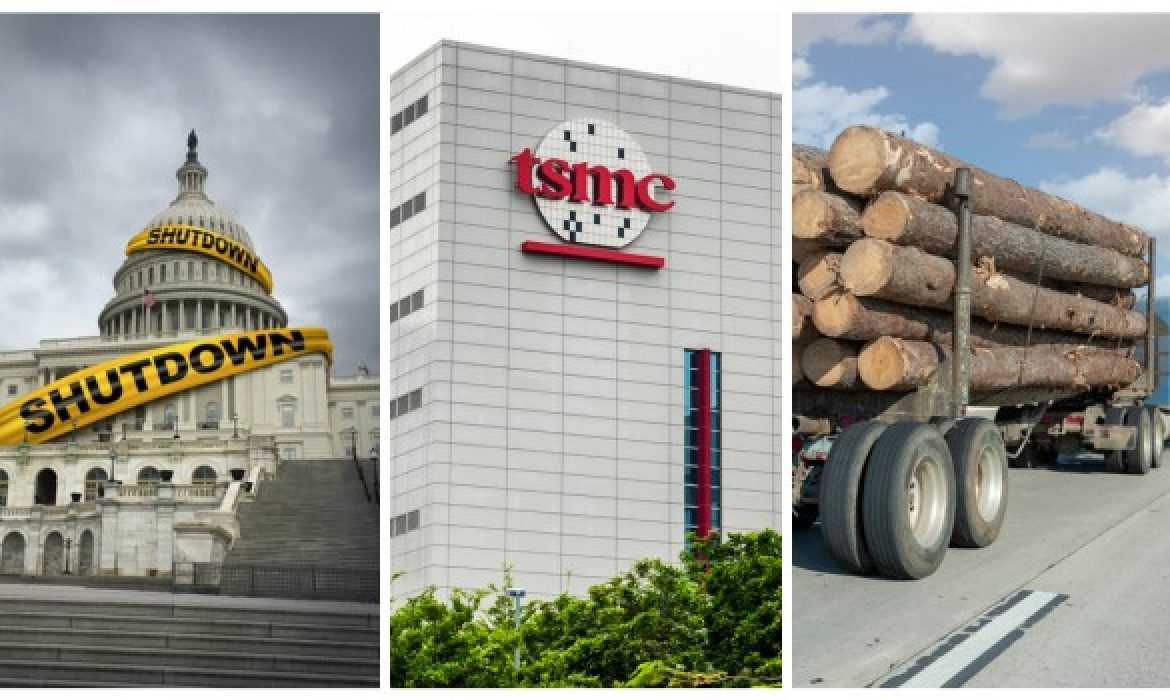
Date Issued – 30th September 2025
Courtesy of the Research Department at Balfour Capital Group
Key Points
- U.S. Shutdown Risks: Trump threatens permanent federal furloughs, raising uncertainty for labor markets and economic data flow.
- Chip Supply Rebalance: Washington pushes Taiwan for a 50-50 chip production split, targeting $500B in U.S. investment to cut reliance on overseas supply chains.
- New Tariffs Introduced: Trump sets new tariffs on lumber, cabinets, and furniture, with duties rising to as high as 50% in January, heightening trade frictions.
- European Layoffs: European companies across autos, banking, energy, and consumer goods announce mass layoffs, underscoring pressure from weak demand and tariffs.
U.S. Shutdown Risks Loom With Threat of Permanent Furloughs
U.S. government shutdowns have historically had limited economic impact, but analysts warn this round could prove different as President Trump has threatened to make some federal furloughs permanent, raising the risk of lasting labor market disruptions. A prolonged shutdown would also delay the release of critical economic data, including the jobs report and inflation readings, potentially leaving the Federal Reserve without key inputs for policy decisions. While most economists see the overall hit to GDP as marginal, the uncertainty over federal employment and data flow introduces risks for markets already sensitive to labor conditions and monetary policy expectations.Washington Presses Taiwan for 50-50 Chip Production Split
The U.S. is pressing Taiwan to agree to a “50-50” arrangement in which half of America’s chip supply would be produced domestically, Commerce Secretary Howard Lutnick said, underscoring Washington’s drive to reduce reliance on Taiwanese semiconductors. Taiwan currently manufactures over 90% of the world’s advanced chips through TSMC, which services major U.S. tech firms. Lutnick outlined a goal of lifting U.S. chip output to 40% by the end of Trump’s term, requiring more than $500 billion in new investment. The plan reflects broader national security and trade concerns, as Washington seeks to balance supply resilience with Taiwan’s strategic role.Trump Imposes Tariffs on Lumber, Cabinets and Furniture
President Trump announced new tariffs on wood products, imposing 10% duties on imported timber and lumber and 25% on cabinets, vanities and upholstered furniture, with rates set to rise to 30% and 50% respectively in January. The measures, delayed until October 14, were justified under Section 232 on national security grounds, citing risks to defense-related supply chains. Canada, the largest softwood supplier, faces added pressure as Ottawa prepares aid for its producers, while Mexico and Vietnam, key furniture exporters, are also impacted. The tariffs add to broader trade frictions, raising costs for U.S. businesses and construction while challenging global partners.European Firms Cut Jobs Amid Economic Slowdown and Tariffs
A growing number of European companies across sectors are cutting jobs as weak demand, high costs, and U.S. tariffs weigh on profitability. Major carmakers including Bosch, Daimler Truck, Stellantis, Volkswagen, and Volvo have announced significant workforce reductions, while banks such as Commerzbank and Lloyds are pursuing cost-cutting through layoffs. Energy firm OMV, chipmaker STMicroelectronics, and luxury brands Burberry and LVMH are also scaling back staff, alongside cuts at Just Eat Takeaway, Lufthansa, and Novo Nordisk. The breadth of reductions underscores the mounting strain on Europe’s economy, with corporate restructuring accelerating in response to slowing growth and external trade pressures.Conclusion
Markets face a complex mix of political risk, trade disruptions, and corporate restructuring. The U.S. government shutdown threat introduces new uncertainty, particularly if prolonged furloughs weaken labor markets or delay critical data releases. Washington’s push to rebalance chip production signals sustained investment flows into semiconductors, but at the cost of heightened geopolitical friction. Expanding tariffs on lumber, furniture, and related goods highlight the administration’s continued reliance on protectionist policy, with broad cost implications. Meanwhile, Europe’s wave of corporate layoffs underscores the mounting strain on growth. Together, these developments reinforce a cautious outlook requiring selective positioning across assets.Investment Insights
- Policy risk: A U.S. shutdown could disrupt data visibility and labor conditions, complicating Fed policy assessments. Investors should monitor private-sector indicators as substitutes.
- Semiconductors: Washington’s drive for onshore chip production underscores long-term capital flows into U.S. manufacturing. Beneficiaries include domestic fabs, equipment suppliers, and construction firms tied to large-scale projects.
- Trade impact: New tariffs on lumber and furniture highlight continued inflationary pressures in housing-related sectors, with downstream effects for builders and retailers.
- Europe: Broad-based layoffs suggest weakening demand and margin pressure. Investors should be cautious on cyclical European equities while favoring defensive or export-led names.
Economic Calendar
| Date | Event | Why It Matters |
|---|---|---|
| October 2, 2025 | U.S. Durable Goods Orders & Factory Orders | Key measure of capital investment demand and business spending momentum. |
| October 2, 2025 | U.S. Initial Jobless Claims | Weekly labor market gauge, closely watched for signs of employment softness. |
| October 3, 2025 | U.S. Nonfarm Payrolls (September) | Most important labor market release, driving Fed policy expectations and market sentiment. |
| October 3, 2025 | U.S. Advance GDP & Chicago PMI | Early read on Q3 growth and manufacturing activity momentum. |
| Early October 2025 | Eurozone Manufacturing & Services PMI | Timely indicator of euro-area growth and ECB policy bias. |
Disclaimer: This newsletter provides financial insights for informational purposes only. It does not constitute financial advice or recommendations for investment decisions.




